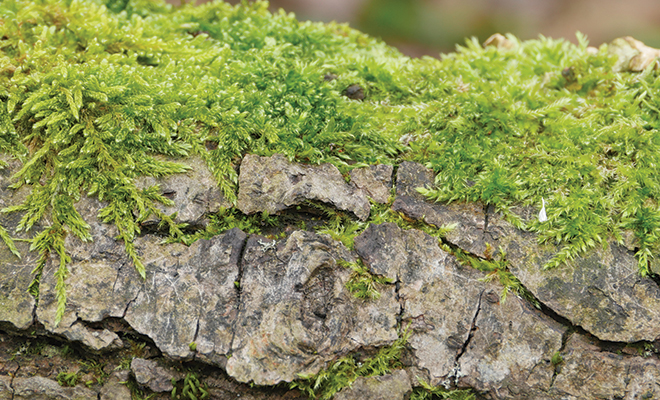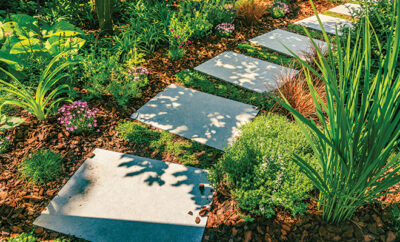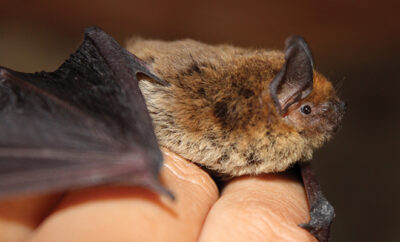
Beautiful Bryophytes: Growing Moss Makes Life Better
Some naturalists refer to moss as “nature’s carpet.” By definition, moss is considered a bryophyte, a small flowerless green plant of the division Bryophyta. These velvety moss cushions don’t have regular roots, flowers or seeds, which gives them an almost floating-on-the ground’s-surface carpet effect.
Moss also comes in a variety of soothing shades of green and incredibly eye-catching textures. Popular varieties include sphagnum moss, Ceratodon moss, cushion moss, haircap moss and reindeer moss, or lichens. Moss typically thrives in shady or dappled sunlight areas, but there are a few varieties that do well in sunny locations. From the lichen-covered walls of Scotland to a simple home-grown fairy garden, mosses are an easy-to-maintain small plant that delivers a big visual impact. But just why would a gardener grow moss?
True Greenness
It is a truly “green” way to grow something green. Moss needs no special pesticides, fertilizers or herbicides or even high-quality soil. Moss is also somewhat critter-proof. Because of internal anti-herbivory compounds, mosses taste bad to typical garden insect pests. Notorious garden marauders such as deer may stomp around on the lush green stuff, but they don’t eat it unless they are part of the reindeer family.
Creating Zen
There is just something calming and magical about moss. The lush green tones of moss work to create a serene and tranquil environment while heightening a sense of being closer to nature. Live plants in workspaces and offices, including moss, have shown to improve creativity and productivity, according to a 2003 Texas A&M study.
Natural Air Cleaner
Moss is particularly good at combating air pollution in outdoor spaces. The pollutants in the rain and the air cling to the surfaces of moss, and while the pollutants are stuck there, bacteria convert them into the plant’s biomass. Moss also does a great job of “scrubbing” the air we breathe of the potentially dangerous contaminants such as aerosols from cleaners, smoke particles, chemical dust and molds found in airborne dust.
Growing Moss Indoors
Growing moss indoors is as simple as creating a terrarium where it can live and flourish. Terrariums can be a basic clear glass container with a lid or a store-bought version from your local garden store.
But your first question may be “Where do I get my moss?” Moss can be collected from nature, from your local garden center or via specialists such as Moss Acres. If you plan on collecting your moss from nearby woods or your own backyard, opt for sheets of the bryophyte when possible. The good news is that moss is resilient. If all you can collect are small pieces, once it’s rehomed in your new terrarium or garden it will grow just as quickly as the big pieces. Collect a mixture of moss from stumps, rocks and the forest floor to add different textures and shades of green to your display.
With moss and glass container in hand, the fun part begins. Place about an inch of pebbles in the bottom of the glass container that will serve as your terrarium and then top that with about an inch of granulated charcoal. Then add two inches of standard potting soil and moisten the whole area with a spray bottle filled with clear water. Press the moss firmly onto the rocks and soil when planting. Mist the moss, cover the container and place it in a room away from bright sunlight. Always be sure to keep your moss terrarium moist; never allow it to dry out.
Growing Moss Outdoors
Homeowners and savvy gardeners love moss because is it an easy way to inject greenness and life into outdoor spaces where nothing else will grow. Moss is a sustainable, shade-loving option for either lawn replacement or sculptural backdrops that can add a lush accent to commercial or residential properties.
Thriving on daily moisture and shade, these bryophytes actually prefer compacted, poor-quality soil and will even be happy with spots that have very little dirt at all, such as rocky areas. It’s a great way to mask unattractive problem areas with very little fuss. As Master Gardener Don Burke of Burke’s Backyard puts it, “Moss is like a Band-Aid® to hide your backyard’s horrible bits.”
Harvesting moss for your outdoors spaces is the same process as collecting it for indoor terrariums. Transplanted mosses in a new outdoor location needs time to acclimate and become established, so daily monitoring and watering is a good idea.
From psychological benefits such as less stress and improved productivity to backyard beautification in a natural way, “nature’s carpet” has a lot to offer. Moss is abundant in nature and free for the taking, but as always, be respectful of Mother Nature and always ask permission when relocating moss from areas that are not your own. ■
Sources: evergreenwalls.com.au, gardeningknowhow.com, gpnmag.com, mossacres.com, mossandstonegardens.com and timberpress.com.







